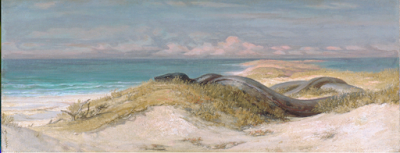 | |
| J. M. W. Turner, Sunrise with Sea Monsters, ca. 1845. Tate Britain |
I was quite thrilled to see Turner’s famous painting, Sunrise with Sea Monsters, at the Art Gallery of Ontario recently. That, coupled with the recent siting of a rare giant squid off the coast of Japan, has inspired me to delve into sightings of sea monsters in art.
 |
| Giant squid sited in Japan’s Toyama Bay, December 24. Source. |
I date my interest in sea monsters back to grade 1, when I was terrified yet mesmerized by It Came from Beneath the Sea, a film about a giant radioactive octopus who trashes San Francisco (watched while under the care of a none-too-attentive teenage babysitter.)
 | |||
| Sea Monkeys - actual product may differ from illustration. |
My obsession continued with a fascination for the much friendlier looking Sea Monkeys, as seen in the back pages of comic books, alongside X-ray glasses, onion gum and black soap. Imagine my disappointment when my friend’s sister Bev ordered a kit and the wee brine shrimp that materialized did not look at all like the fun-loving family unit pictured in the ad.
 |
| Mishipeshu, Awaga Rock on Lake Superior. She's the one with the horns. Source. |
Growing up by Lake Superior predisposes one to love all things watery though. Canada’s deepest, coldest lake is the home of Mishipeshu, aka the Underwater Panther. Failure to acknowledge her greatness through the appropriate rituals may be grounds for having one’s canoe tipped!
 |
| William Blake, Behemoth and Leviathan, 1805-06. Source. |
For English visionary William Blake, the sea monster Leviathan represented war by sea. In this original watercolour for his engraved Illustrations to the Book of Job, the sea serpent is paired with Behemoth, depicted here as four-legged creature of indeterminate sort.
 |
| Alfred Kubin, Fright, 1901, Leopold Museum, Vienna. Source. |
The Symbolists, spiritual heirs to the Romantics, and lovers of all things macabre, also had a fondness for monstrous creatures of the deep. Austrian artist Alfred Kubin specialized in eerie drawings of perversely strange chimera that simultaneously dwarf us pathetic humans and mirror our inner demons.
 |
| Elihu Vedder, Lair of the Sea Serpent, 1899. Source. |
Elihu Vedder’s serpent is a more ambiguous fellow. Is he (or she) just enjoying the day, or waiting for the unsuspecting person, fish or seal who will become lunch? Or a lover who said they'd come back then didn't?
 | ||
| Huang Yong Ping, Serpent d’océan, 2012, Loire River, length 425 feet. Photo by Emmanuel Le Guellec. |
This magnificent aluminium skeleton by Huang Yong Ping suggests the eventual fate of Vedder’s solitary creature, and indeed of us all.
Canadian poet David Clink's poem, "A sea monster tells his story”, captures the melancholy of this lonely creature, misunderstood but just as full of feeling as any of us two-legged types. You can read this Aurora Award winning poem here.